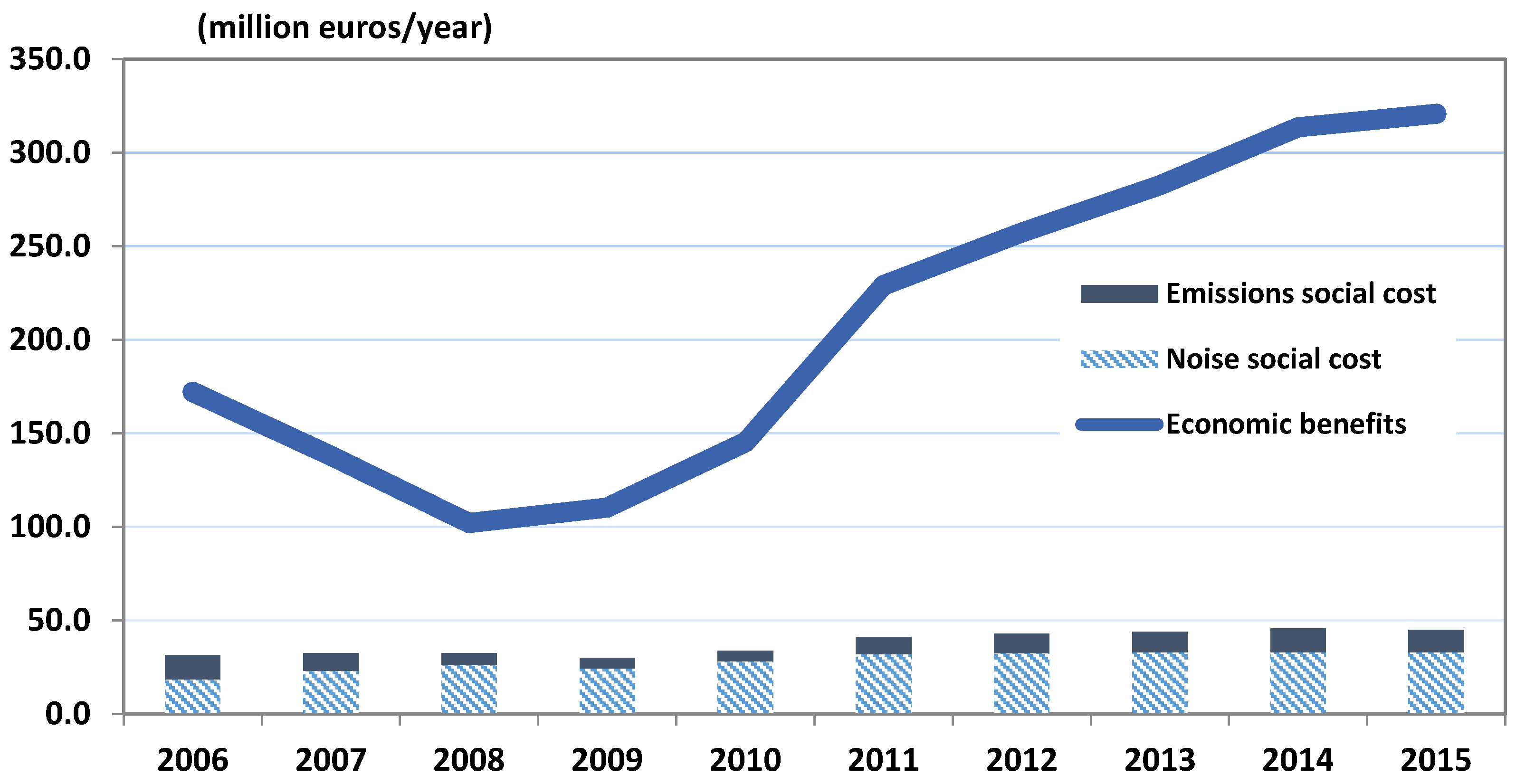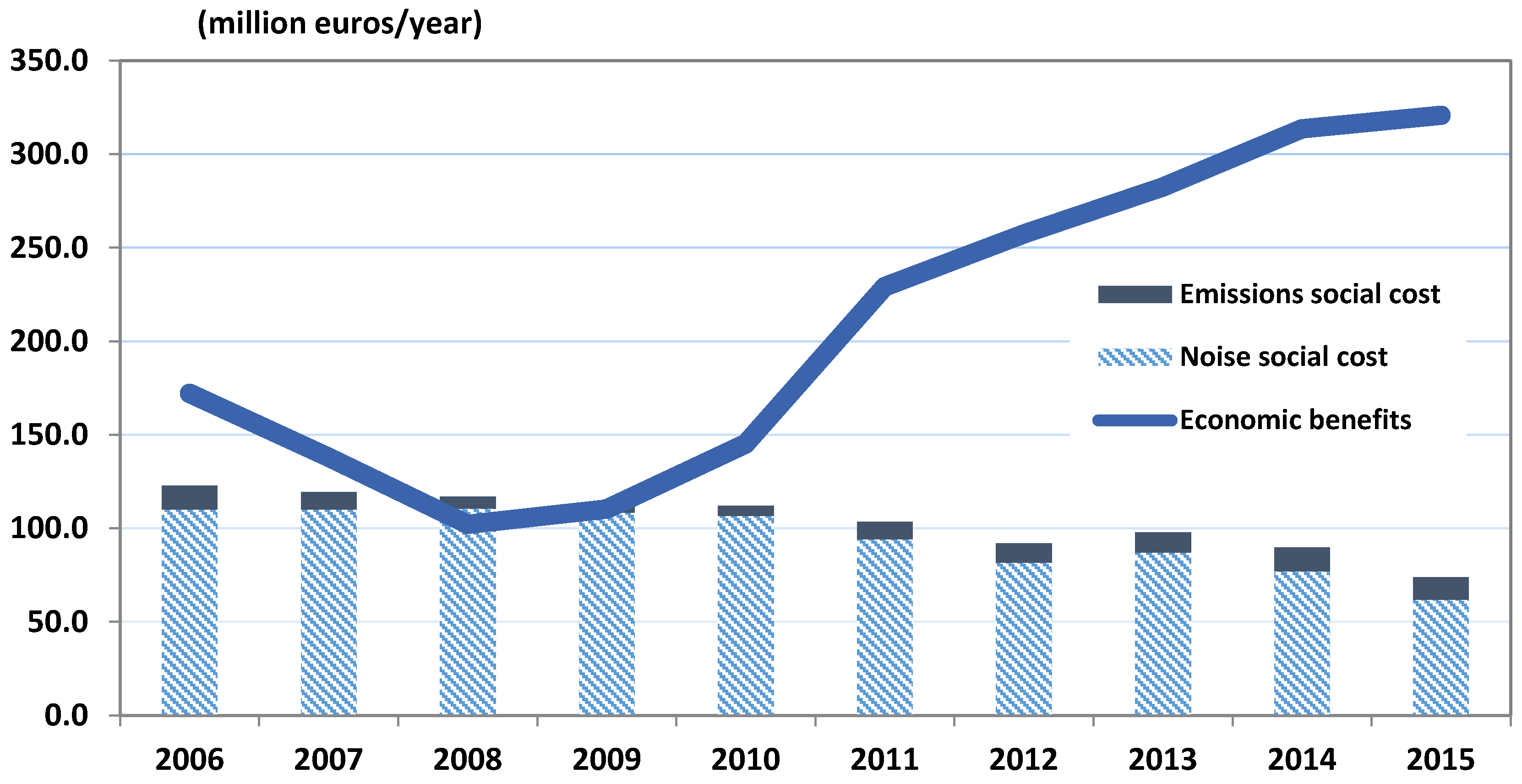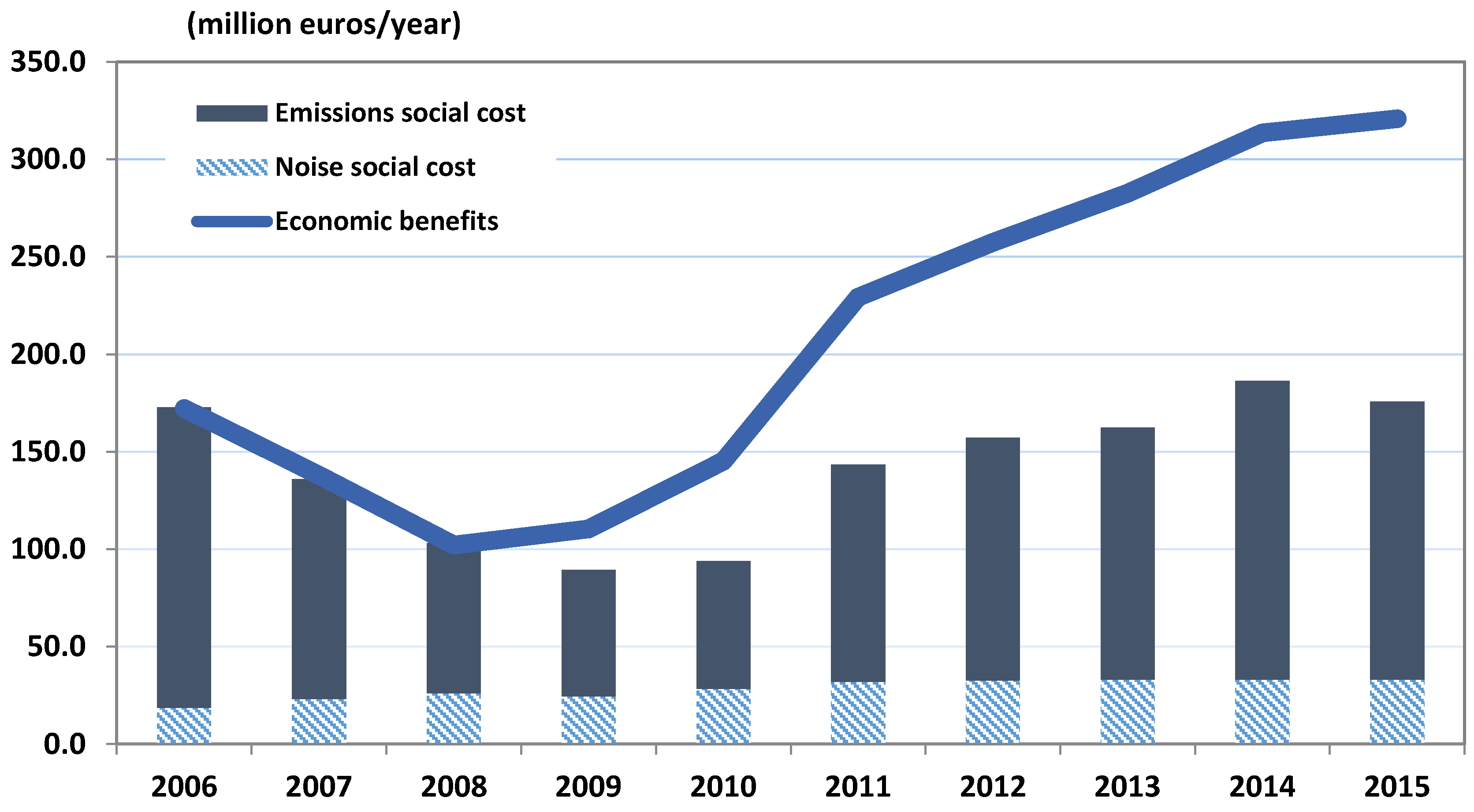Is There a Limit to Growth? Comparing the Environmental Cost of an Airport’s Operations with Its Economic Benefit
Abstract
:1. Introduction
2. Methodology
2.1. Estimating the Social Cost of Airport Emissions
2.2. Estimating Aircraft Noise Social Cost
2.3. Methods for Evaluating Income Generation of Airport Operations
- α: Employment-dependency ratio, , calculated by using the regional population, N, divided by total employment in the region (ER);
- β: Non-basic employment ratio; , calculated by taking the total employment in the non-basic industry (Ea) divided by total employment in the region. (Note that the service industry is later found to be the basic industry for Taipei in this case—see Section 3.3).
- LQi = 0, shows that there is no industry i in this region;
- LQi > 1, indicates that industry i has a tendency to be concentrated and specialized; a basic industry;
- LQi < 1, shows that industry i has no concentrated and specialized trend; a non-basic industry.
3. Empirical Analysis—Taipei Songshan Airport
3.1. Airport Emission Costs
3.2. Aircraft Noise Social Costs
- -
- Class 1: areas between 60-65 dB(A) of aircraft noise day-night average sound level (Ldn);
- -
- Class 2: areas between 65-75 dB(A);
- -
- Class 3: areas exposed to noise higher than 75 dB(A).
3.3. Employment Opportunities and Income Generation
- Primary industries include agriculture, agribusiness, forestry, fishing, mining, and quarrying industries;
- Secondary industries are those such as aerospace and automobile manufacturing, brewing and the tobacco industry, the chemical industry, the textile industry, the energy industry, steel production and metalworking, industrial equipment production, and consumer electronics;
- Tertiary industry is the service industry.
3.4. The Comparison of Environmental Costs and Economic Benefits
4. Conclusions
Acknowledgments
Conflicts of Interest
References
- Airports Council International Europe-ACI Europe. 2004. The Social and Economic Impact of Airports in Europe. Brussels: Airports Council International Europe-ACI Europe. [Google Scholar]
- Airports Council International Europe-ACI Europe. 2009. Creating Employment and Prosperity in EUROPE. Brussels: Airports Council International Europe-ACI Europe. [Google Scholar]
- Airports Council International Europe-ACI Europe. 2016. Economic Impact of European Airports—A Critical Catalyst to Economic Growth; by InterVISTAS, 2015. Available online: http://www.intervistas.com/downloads/reports/Economic%20Impact%20of%20European%20Airports%20-%20January%202015.pdf (accessed on 20 July 2016).
- Airports Council International-ACI. 2006. Airports Stimulate Employment and Economic Growth. Geneva: Airports Council International-ACI. [Google Scholar]
- Dhar, Divya, Alexandra Macmillan, Graeme Lindsay, and Alistair Woodward. 2009. Carbon pricing in New Zealand: Implications for public health. Journal of the New Zealand Medical Association 122: 105–15. [Google Scholar]
- Dings, Jos M. W., Ron C. N. Wit, B. A. Leurs, and M. D. Davidson. 2005. External costs of aviation; Environmental Research of the Federal Ministry of the Environment. Nature Conservation and Nuclear Safety, Research Report 299 96 106, UBA-FB 000411, 2003. Available online: http://www.umweltbundesamt.de/sites/default/files/medien/publikation/long/2297.pdf (accessed on 10 June 2015).
- European Aviation Safety Agency-EASA. 2015. ICAO Aircraft Engine Emissions Databank. Available online: http://www.easa.europa.eu/home.php (accessed on 15 May 2015).
- European Organisation for the Safety of Air Navigation-EUROCONTROL. 2005. Aircraft Retrofit Action to Comply to the 8.33 khz Vertical Expansion Programme. Brétigny-sur-Orge: European Organisation for the Safety of Air Navigation-EUROCONTROL. [Google Scholar]
- European Organisation for the Safety of Air Navigation-EUROCONTROL. 2015. Standard Inputs for EUROCONTROL Cost-Benefit Analyses. Edition Number: 7.0. Brussels: European Organisation for the Safety of Air Navigation-EUROCONTROL. [Google Scholar]
- ExternE-Pol. 2005. Externalities of Energy: Extension of Accounting Framework and Policy Applications. Project Funded by the European Commission. Brussels: European Commission. [Google Scholar]
- Gallagher, Kevin P. 2005. International trade and air pollution: Estimating the economic costs of air emissions from waterborne commerce vessels in the United States. Journal of Environmental Management 77: 99–103. [Google Scholar] [CrossRef] [PubMed]
- Garin, Robert A. 1966. A matrix formulation of the Lowry Model for intrametropolitan activity allocation. Journal of the American Institute of Planners 32: 361–64. [Google Scholar] [CrossRef]
- Graham, Anne. Economic and social impacts of airports. In Managing Airports—An International Perspective, 4th ed. London: Elsevier, pp. 263–85. ISBN 10:0415529417.
- Guldmann, Jean-Michel, and Fahui Wang. 1998. Population and employment density functions revisited: A spatial interaction approach. Regional Science 77: 585–610. [Google Scholar] [CrossRef]
- Hsieh, Hui-Dee. 2004. A Cost-Benefit Analysis of Sung-Shan Airport on District Development. Master thesis, Institute of Traffic and Transportation, National Chiao Tung University, Taiwan. (In Mandarin). [Google Scholar]
- Ju, Yaw-Guang. 2016. Kaohsiung International Airport, Kaohsiung, Taiwan. Personal communication.
- Jun, Myung-jin, and James E. Moore. 2002. The Lowry model revisited: Incorporating a multizonal input-output model into an urban land use allocation model. Review of Urban & Regional Development Studies 14: 2–17. [Google Scholar]
- Lee, Min-Hua. 2005. The Impacts of the Ten New Major Construction Projects on Taiwan’s Regional Economics: An Application of the Multi-Regional Input-Output Model. Master’s thesis, Institute of Economics, National Sun Yat-sen University, Taiwan. (In Mandarin). [Google Scholar]
- Lu, Cherie. 2011. The economic benefits and environmental costs of airport operations: Taiwan Taoyuan International Airport. Journal of Air Transport Management 17: 360–63. [Google Scholar] [CrossRef]
- Lu, Cherie. 2014. Combining a theoretical approach and practical considerations for establishing aircraft noise charge schemes. Applied Acoustics 84: 17–24. [Google Scholar] [CrossRef]
- Lu, Cherie, and Chih-Gang Liu. 2014. The impact of changes in civil aviation traffic on an airport’s economic benefits and environmental costs—A case study of Taipei Songshan Airport. Maritime Quarterly 23: 1–17. (In Mandarin). [Google Scholar]
- Lu, Cherie, and Peter Morrell. 2006. Determination and applications of environmental costs at different sized airports—Aircraft noise and engine emissions. Transportation 33: 45–61. [Google Scholar] [CrossRef] [Green Version]
- Nelson, Jon P. 1980. Airports and property values: A survey of recent evidence. Journal of Transport Economics and Policy 14: 37–52. [Google Scholar]
- Nelson, Jon P. 1981. Measuring benefits of environmental improvements: Aircraft noise and hedonic prices. Advances in Applied Microeconomics 1: 51–75. [Google Scholar]
- Pagoni, Ioanna, and Voula Psaraki-Kalouptsidi. 2016. The impact of carbon emission fees on passenger demand and air fares: A game theoretic approach. Journal of Air Transport Management 55: 41–51. [Google Scholar] [CrossRef]
- Pearce, David William, and Anil Markandya. 1989. Environmental Policy Benefits: Monetary Valuation. Paris: Organisation for Economic Cooperation and Development-OECD, ISBN 10:9264131825. [Google Scholar]
- Postorino, Maria Nadia, and Luca Mantecchini. 2016. A systematic approach to assess the effectiveness of airport noise mitigation strategies. Journal of Air Transport Management 50: 71–82. [Google Scholar] [CrossRef]
- Schipper, Youdi. 2004. Environmental costs in European aviation. Transport Policy 11: 141–54. [Google Scholar] [CrossRef]
- Taipei City Statistics. 2016. Department of Budget, Accounting and Statistics, Taipei City Government. Available online: http://dbas.gov.taipei/np.asp?ctNode=6151&mp=120001 (accessed on 25 July 2017).
- Taiwan Civil Aviation Statistics. 2016. Taiwan Civil Aeronautics Administration. Available online: https://www.caa.gov.tw/big5/content/index.asp?sno=186 (accessed on 25 July 2017).
- Taiwan National Statistics. 2016. Directorate-General of Budget, Accounting and Statistics, Executive Yuan, R.O.C. Taiwan. Available online: http://www.dgbas.gov.tw/mp.asp?mp=1 (accessed on 25 July 2017).
- United Kingdom Department of Environment, Transport and Regions (UK DETR). 2000. Valuing the External Costs of Aviation; London: UK DETR.
- Voltes-Dorta, Augusto, and Juan Carlos Martín. 2016. Benchmarking the noise-oriented efficiency of major European airports: A directional distance function approach. Transportation Research Part E: Logistics and Transportation Review 91: 259–73. [Google Scholar] [CrossRef]
| 1 | dB(A): the A-weighted decibel units, adjusted to conform with the frequency response of the human ear. |
| 2 | Taipei population divided by total employment in Taipei—see Table 6. |
| 3 | The employment of non-basic (primary and secondary) industries divided by total employment in Taipei—see Table 6. |



| Pollutant | Average | Figures from Literature |
|---|---|---|
| CO2 | 0.03 | 0.01, 0.02, 0.04 |
| HC | 8.86 | 0.72, 2.27, 2.70, 5.00, 8.90, 13.76 |
| CO | 0.06 | 0.01, 0.03, 0.06, 0.19 |
| NOX | 11.83 | 1.00, 1.88, 2.90, 3.20, 4.00, 11.49, 12.00, 13.00, 38.10 |
| SOX | 12.26 | 1.00, 1.53, 2.90, 3.00, 8.50, 10.73, 11.06, 40.99, 50.00 |
| PM | 292.88 | 5.09, 30.36, 75.89, 107.25, 291.81, 319.50, 600.00 |
| Year | Passenger Traffic | Aircraft Movement | Cargo (Tonnes) |
|---|---|---|---|
| 2015 | 5,861,902 | 57,597 | 45,217 |
| 2014 | 6,105,403 | 61,881 | 43,528 |
| 2013 | 5,847,275 | 60,066 | 36,319 |
| 2012 | 5,676,411 | 58,170 | 31,311 |
| 2011 | 5,258,975 | 58,185 | 34,492 |
| 2010 | 3,712,841 | 48,925 | 14,355 |
| 2009 | 3,091,066 | 44,655 | 11,405 |
| 2008 | 3,101,854 | 49,264 | 11,830 |
| 2007 | 4,470,859 | 68,084 | 13,115 |
| 2006 | 6,728,709 | 87,955 | 15,024 |
| Aircraft Type | Cost per LTO (Euros/LTO) | Aircraft Type | Cost per LTO (Euros/LTO) |
|---|---|---|---|
| B737 | 296 | DH8 | 225 |
| B757/767 | 583 | ATR72 | 108 |
| B787 | 872 | ERJ-190 | 177 |
| A320 | 254 | MD-90 | 315 |
| A321 | 375 | MD-82/83 | 311 |
| A330 | 756 | Business jets | 167 |
| Year | Aircraft LTO | Euros per LTO | Aircraft Emission Cost (m Euros/Year) | Other Airport CO2 Cost (m Euros/Year) | Total Emission Cost (m Euros/Year) |
|---|---|---|---|---|---|
| 2015 | 28,799 | 321 | 9.3 | 2.6 | 11.9 |
| 2014 | 30,941 | 321 | 9.9 | 2.8 | 12.8 |
| 2013 | 30,033 | 279 | 8.4 | 2.4 | 10.8 |
| 2012 | 29,085 | 278 | 8.1 | 2.3 | 10.4 |
| 2011 | 29,093 | 247 | 7.2 | 2.1 | 9.3 |
| 2010 | 24,463 | 167 | 4.1 | 1.4 | 5.5 |
| 2009 | 22,328 | 183 | 4.1 | 1.3 | 5.4 |
| 2008 | 24,632 | 199 | 4.9 | 1.5 | 6.4 |
| 2007 | 34,042 | 211 | 7.2 | 2.2 | 9.4 |
| 2006 | 43,978 | 223 | 9.8 | 3.1 | 12.9 |
| Year | Annual House Rent (Euro/Year) | Estimated Households within 60 Ldn Contour | Noise Social Cost (m Euros/Year) |
|---|---|---|---|
| 2015 | 14,191 | 25,501 | 33.0 |
| 2014 | 14,224 | 25,423 | 33.0 |
| 2013 | 14,320 | 25,345 | 33.1 |
| 2012 | 14,092 | 25,267 | 32.5 |
| 2011 | 14,070 | 24,810 | 32.0 |
| 2010 | 12,574 | 24,473 | 28.3 |
| 2009 | 10,937 | 24,318 | 24.5 |
| 2008 | 11,718 | 24,185 | 26.1 |
| 2007 | 10,407 | 24,093 | 23.1 |
| 2006 | 8368 | 24,053 | 18.6 |
| Industry | Taipei City Employment | Taiwan Employment | Taipei Location Quotient | ||
|---|---|---|---|---|---|
| (000) | % | (000) | % | ||
| Primary Industry | 2 | 0.2 | 548 | 4.9 | 0.03 |
| Secondary Industry | 238 | 18.8 | 4004 | 36.2 | 0.52 |
| Tertiary Industry | 1023 | 81.0 | 6526 | 58.9 | 1.38 |
| Total | 1263 | 100.0 | 11,078 | 100.0 | - |
| Year | Total Employment | Multiplier | Direct Income (m Euros/Year) | Secondary Income (m Euros/Year) | Total Income (m Euros/Year) |
|---|---|---|---|---|---|
| 2015 | 8853 | 1.68 | 234.8 | 86.0 | 320.8 |
| 2014 | 8755 | 1.69 | 228.7 | 84.9 | 313.6 |
| 2013 | 8100 | 1.73 | 202.5 | 80.1 | 282.6 |
| 2012 | 7315 | 1.72 | 185.4 | 72.0 | 257.4 |
| 2011 | 6424 | 1.75 | 165.6 | 63.6 | 229.2 |
| 2010 | 4263 | 1.77 | 101.0 | 44.2 | 145.2 |
| 2009 | 3279 | 1.77 | 76.7 | 33.7 | 110.3 |
| 2008 | 2952 | 1.73 | 72.0 | 30.1 | 102.1 |
| 2007 | 3965 | 1.77 | 95.7 | 42.3 | 138.0 |
| 2006 | 5533 | 1.83 | 112.6 | 59.6 | 172.2 |
© 2017 by the author. Licensee MDPI, Basel, Switzerland. This article is an open access article distributed under the terms and conditions of the Creative Commons Attribution (CC BY) license (http://creativecommons.org/licenses/by/4.0/).
Share and Cite
Lu, C. Is There a Limit to Growth? Comparing the Environmental Cost of an Airport’s Operations with Its Economic Benefit. Economies 2017, 5, 44. https://doi.org/10.3390/economies5040044
Lu C. Is There a Limit to Growth? Comparing the Environmental Cost of an Airport’s Operations with Its Economic Benefit. Economies. 2017; 5(4):44. https://doi.org/10.3390/economies5040044
Chicago/Turabian StyleLu, Cherie. 2017. "Is There a Limit to Growth? Comparing the Environmental Cost of an Airport’s Operations with Its Economic Benefit" Economies 5, no. 4: 44. https://doi.org/10.3390/economies5040044




